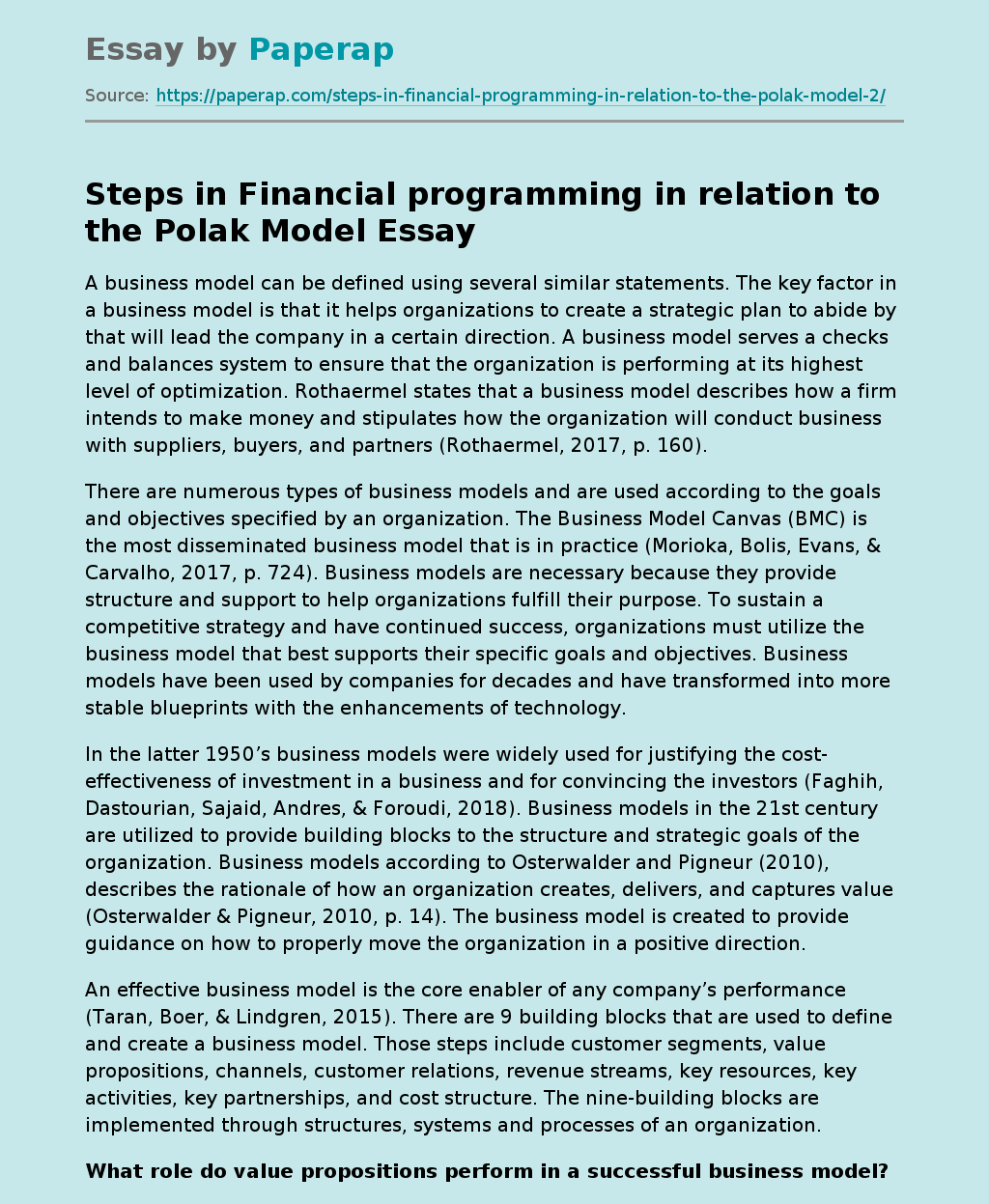Defining Business Model for Strategic Creation
A business model can be defined using several similar statements. The key factor in a business model is that it helps organizations to create a strategic plan to abide by that will lead the company in a certain direction. A business model serves a checks and balances system to ensure that the organization is performing at its highest level of optimization. Rothaermel states that a business model describes how a firm intends to make money and stipulates how the organization will conduct business with suppliers, buyers, and partners (Rothaermel, 2017, p.
160).
There are numerous types of business models and are used according to the goals and objectives specified by an organization. The Business Model Canvas (BMC) is the most disseminated business model that is in practice (Morioka, Bolis, Evans, & Carvalho, 2017, p. 724). Business models are necessary because they provide structure and support to help organizations fulfill their purpose. To sustain a competitive strategy and have continued success, organizations must utilize the business model that best supports their specific goals and objectives.
Business models have been used by companies for decades and have transformed into more stable blueprints with the enhancements of technology.
In the latter 1950’s business models were widely used for justifying the cost-effectiveness of investment in a business and for convincing the investors (Faghih, Dastourian, Sajaid, Andres, & Foroudi, 2018). Business models in the 21st century are utilized to provide building blocks to the structure and strategic goals of the organization. Business models according to Osterwalder and Pigneur (2010), describes the rationale of how an organization creates, delivers, and captures value (Osterwalder & Pigneur, 2010, p.
14). The business model is created to provide guidance on how to properly move the organization in a positive direction.
An effective business model is the core enabler of any company’s performance (Taran, Boer, & Lindgren, 2015). There are 9 building blocks that are used to define and create a business model. Those steps include customer segments, value propositions, channels, customer relations, revenue streams, key resources, key activities, key partnerships, and cost structure. The nine-building blocks are implemented through structures, systems and processes of an organization.
What role do value propositions perform in a successful business model?
Value propositions are factors that are used in the creation of a business model. Value propositions represent a bundle of products and services that create value for a specific customer segment. Customer segments can be defined as a community of customers and or businesses that are the target market for the selling of specific product or service. The customer segment is one of the most important building blocks in the Canvas stage of the business model. The value proposition building block is of is important because it is centered around the satisfaction of customers.
Value propositions also serve as a binding agreement from the organization to the consumer that the products and services that are offered are high quality. To be effective value proposition must be clear and concise and address the needs and demands of customers. Customer satisfaction is important to businesses because satisfied customers become loyal to the company. Value propositions inform consumers as to why they should purchase from a specific company and differentiate products and services that may be provided by a competitor. Value propositions need to be strategically formulated as to attract the consumers who would have greatest benefit from the specified products and services.
How does Brainstorming New Business Models” by answering the “What If” questions impact successful businesses?
Brainstorming assists individuals in discussing new ideas and providing answers to uncertainties that may be associated with the idea. According to Osterwalder and Pigneur (2010), What if questions help us break free from constraints imposed by current models (Osterwalder & Pigneur, 2010, p. 140). Brainstorming is an inexpensive way to solve problems and assist organizations in making changes to current business models structures. Brainstorming helps organizations to address future situations by asking the “what-if” questions and create different alternatives to implement new business strategies.
Appropriately addressing “what-if” questions permit organizations to continuously evaluate current business models and explore future opportunities. What-if questions impact a successful business because the questions serve as a guide to address impending situations that the organization could be faced with. Companies that understand the power of answering the what-if create a competitive advantage for themselves. Answering what-if questions provide present and future stabilization to prepare for the unknown.
Defining Business Model for Strategic Creation. (2021, Dec 05). Retrieved from https://paperap.com/steps-in-financial-programming-in-relation-to-the-polak-model-2/

